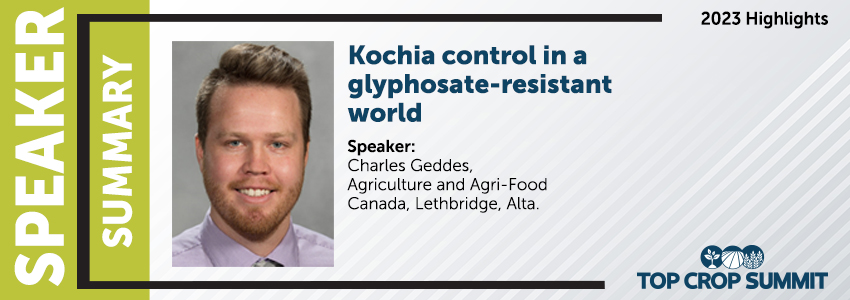
Features
Top Crop Summit
Top Crop Summit speaker series: Kochia control in a herbicide-resistant world
April 5, 2023 By Bruce Barker

Dr. Charles Geddes is a research scientist with Agriculture and Agri-Food Canada at Lethbridge, Alta. He leads the weed ecology and cropping systems research program overseeing a diverse range of research. At the Top Crop Summit on Feb. 23, he discussed the challenges of controlling herbicide-resistant kochia in Western Canada.
Kochia is a challenging weed to control. It emerges throughout the year, is genetically diverse, can produce up to 100,000 seeds per plant, spreads as tumbleweed, outcrosses between plants and is tolerant of heat, drought and saline stresses. Crop yield loss from competition can be high.
The confirmation of herbicide resistance in kochia stretches back many years. Across the Prairies, all kochia populations are now assumed to be resistant to Group 2 ALS inhibitors.
The 2021 Alberta herbicide-resistance survey found 78 per cent of populations resistant to glyphosate, 28 per cent to dicamba and 44 per cent to fluroxypyr. Triple resistance to Group 2 ALS inhibitors, glyphosate and at least one of the Group 4 synthetic auxins was found at 45 per cent of the sites.
The 2019 survey in Saskatchewan identified 87 per cent of populations were resistant to glyphosate and 45 per cent resistant to dicamba. All populations are also assumed to be resistant to Group 2 herbicides.
In Manitoba, the 2018 survey found 58 per cent of populations were resistant to glyphosate and one per cent to dicamba, as well as all populations resistant to Group 2 herbicides.
A significant development in herbicide-resistant kochia is the confirmation of Group 14 PPO inhibitor resistance in kochia found in Saskatchewan in 2021. Group 14 herbicides are a valuable chemistry for controlling herbicide-resistant kochia, and the loss of them would seriously compromise layering control of kochia.
Overall, the estimated cost of herbicide-resistant kochia, taking into consideration yield loss and adjusted herbicide programs, is $222 million on the Prairies.
Geddes is conducting trials on herbicide-resistant kochia management. These research trials are on-going. The inclusion of winter wheat in two years of four-year crop rotations reduced kochia biomass by 64 per cent compared to rotations consisting only of summer annual crops.
Layering cultural and chemical weed control is also being investigated. The use of nine-inch narrow rows and doubled crop seeding rates reduced kochia biomass by 80 per cent, and the kochia seedbank by 63 per cent over a four-year crop rotation at Lethbridge compared with 18-inch wide rows and recommended seeding rates.
Another research trial is looking at the effect of canola plant stand on kochia density. Canola plant stand is targeted at 50 and 100 plants/m2 (or five and 10 plants per square foot), under a range of kochia population densities. The first two years of research found higher canola plant stands produced increased weed competition, and dramatically increased the five per cent action threshold level where herbicide application was required, meaning the crop could withstand higher kochia densities.
Research is also looking at the timing of pre- and post-harvest applications of glyphosate plus saflufenacil to determine the effect of application timing on viable kochia seeds at harvest. The lowest kochia seed production was at the application date targeting Aug. 22, and the highest at application dates targeting Sept. 19 and Oct. 4.
Overall, there is no silver bullet for control of herbicide-resistant kochia. It will take an integrated management approach that combines cultural, agronomic and herbicide control. And, because kochia is a tumbleweed that can spread from farm to farm, control will require a community-based or area-wide strategy.